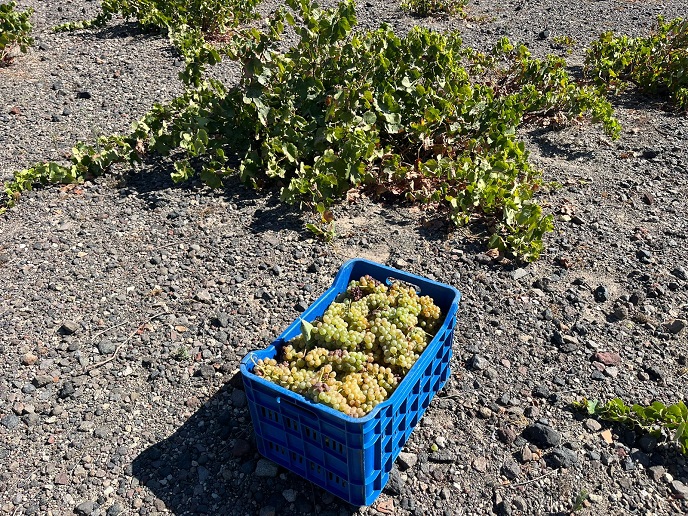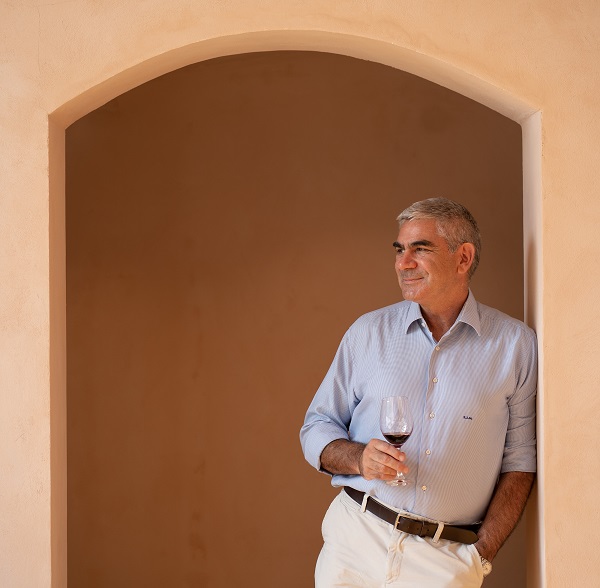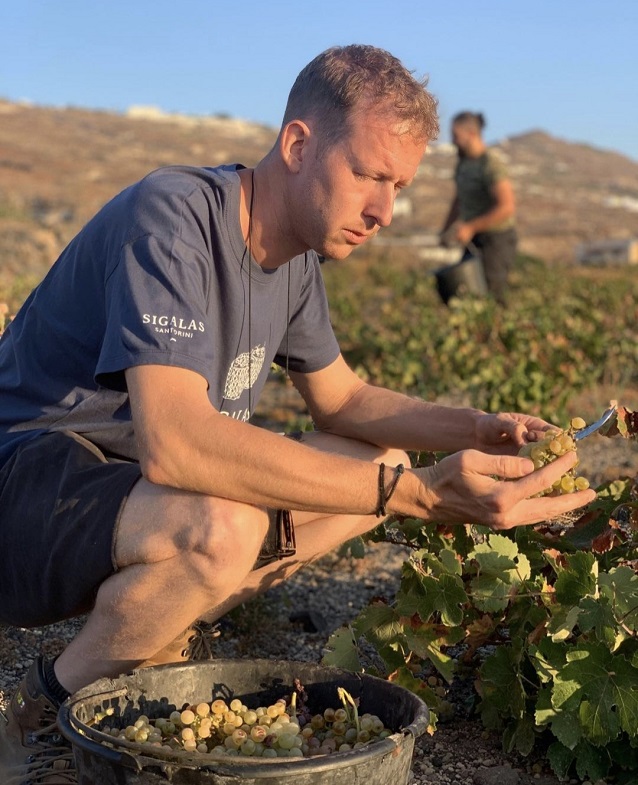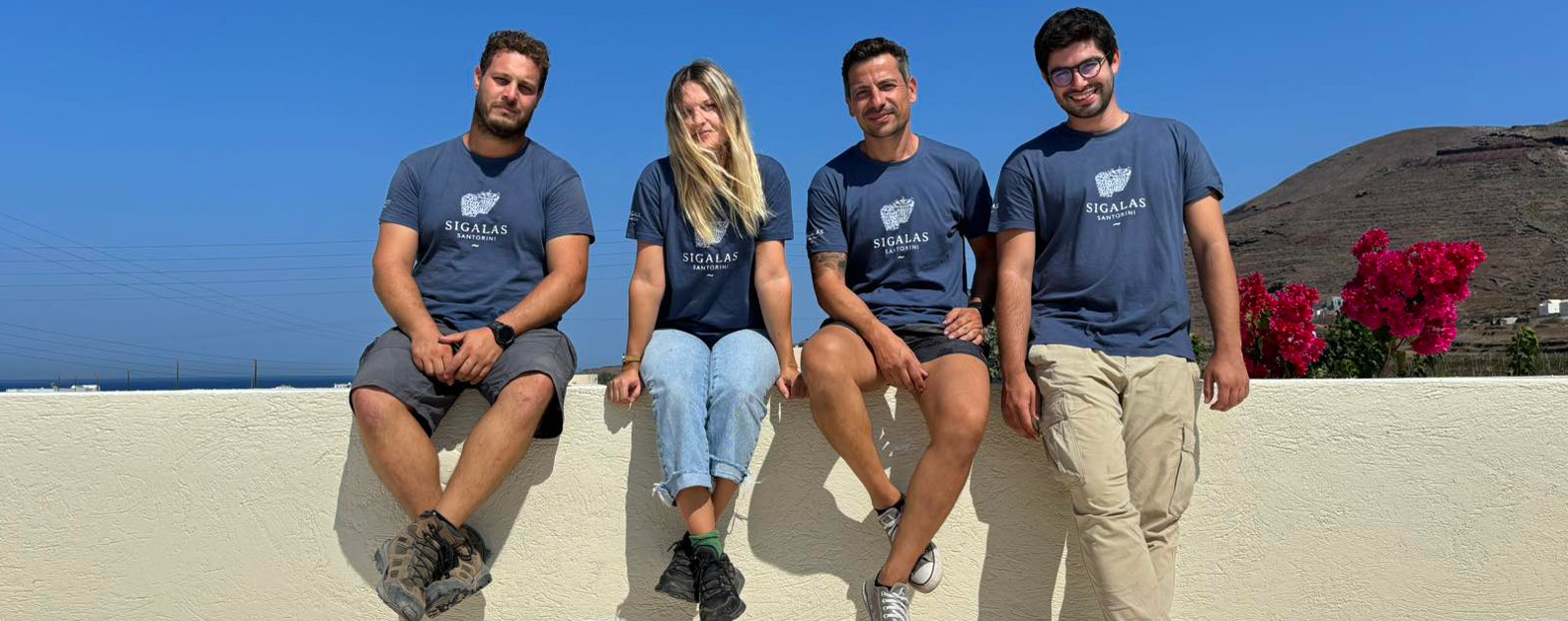However, there is a silver lining. The quality is “outstanding”.

As it looks as if these are the conditions that vignerons will have to adapt to, Domaine Sigalas is researching and making plans accordingly.
“Climate change demands a strategic shift in the way we think, leaving behind rigidities and stereotypical narratives,” Stellios says. “At Domaine Sigalas we have accelerated our investment in that direction, focusing on scientific knowledge and research. When we say that the Santorinian viti-vini heritage must be preserved, we mean to render it sustainable not a museum piece. We are working for a dynamic future that will be able to highlight the uniqueness of the local vineyard, together with its ability to adapt and regenerate when needed. Resilience is among the most valuable legacies and the most powerful incentives for the next generations of the island’s growers to carry on.”
According to Kostas Tellis, Domaine Sigalas’ viticulturist, “the weather conditions recorded during the 2023-2024 growing season were a synthesis and a sequence of adversities. Still the extra burden came from the fact that those patterns followed and built on the equally tough challenges of the previous year. That is the critical factor that increases the complexity of the challenges we have to tackle.”
After a warm winter, early budbreak, higher average temperatures, stressed vines, lack of dew, lower rainfall, windstorms, and hail, total production on the island fell by 30-40%. As a result, the price of the grapes increased by 20-30% compared to last year, reaching the highest ever price in Santorini vineyards. What makes things worse is that 2024’s low production comes after low yields in 2023, too.
Stellios puts it in perspective: “If we want to talk in comparison with the average of the last 15 years, we are talking of a decrease of 60, even 65%.”
'A decrease of 60, even 65%'The dry weather, constant winds and limited vegetative growth of the plants, however, meant that the health of the vines was exceptional in every part of the island but especially around the village of Oia, where the vast majority of Domaine Sigalas’ production grows.
The conditions also led to one of the earliest harvests in recent years. “We kicked off with Mavrotragano (red) on July 29 and with Mandilaria (red) a few days later. We continued with Assyrtiko (white) and Athiri (white) starting from the earliest harvested areas and reached the 16th of August to receive the always last to harvest variety of Aidani (white),” Stellios says.
But the wines are looking “excellent”, according to winemaker Sara Iakovidou. Assessing the wines towards the end of fermentation, she says: “Assyrtiko with body and structure, very good acidity level, fruit-forward. Rich aromas for Mavrotragano, with good acidity and rich colour.” The only thing missing from the 2024 vintage, she says, “is the quantity”.
Q&A

Canopy caught up with Stellios (above), who comes from one of the most historic Greek wine families (Boutaris), shortly after the grapes arrived in the cellar.
His father, Yiannis Boutaris, went out on his own and founded Kir-Yianni winery in 1997. Stellios has been helming this estate since 2004, along with two estates in northern Greece – in the Naoussa and Amyndeon regions (key appellations for the Xinomavro variety). Since 2020, Stellios has also been running Domaine Sigalas in Santorini – the island where he made his first harvest in 1985.
Canopy: Was the drop in your total production similar to the island’s 30-40% decrease?
Stellios Boutaris: “We were more on the 30% side as the village of Oia, from where comes most of our production, faced a milder heat stress (3-4°C lower) during summer compared to areas lying within the island’s interior. Oia is a coastal village, located at the northernmost part of Santorini, where the northern wind blows straight from the sea without any interruption (geographical or other). Even more so, we were not to be struck by the hail.”
Was it really “two baskets of grapes”?
Stellios: “In Greek, when we want to describe something that is in small quantity, we usually use the number two (two bags, two baskets, two things…)
“Following the growing season 2023-2024, it was evident that this vintage will be low in production. ‘Two baskets of grapes’ was something I was saying right from the start in order to highlight the small production expected. And that inspired the drawing on our 2024 harvest t-shirt (see main photo) – the two traditional baskets, which became an (internal) slogan.”
How can you make grapegrowing on the island economically sustainable in the future?
Stellios: “In Santorini everything is more expensive. The land, the water, the wages, the accommodation…
“The key word for economic sustainability is restructure. Restructuring – and expanding – the total acreage under vines, restructuring the business. That means higher prices for a product that is totally worth it considering the quality, the obscurity, the heroic viticulture and the singular character of Santorini wines.”
Wouldn’t it be easier to sell the land to a property developer and go and sit in a pool?
Stellios: “Of course it would be. But that is not what we do. On the contrary, our job – or even better, our mission – is to preserve by adjusting and improving. We must work on finding a sustainable balance between the touristic development, the local way of living, the natural landscape, and the vineyards.”
Why is it worth preserving Santorini’s vineyards?
Stellios: “Santorini is a unique heritage site, one of the few vineyards in the world counting more than 3,000 years of uninterrupted vine-growing. It is a cultural ark that has endured against hardships and challenges for thousands of years because of man’s ingenuity and craftmanship, as well as because of the phylloxera-immune soils. So, there is absolutely no question if it is worth saving. As there is absolutely no way we will abandon a vineyard that has lived on. Not on our watch.”
‘There is absolutely no way we will abandon a vineyard’What are you investing in to make sure?
Stellios: “We are investing in the expansion of our land, in science and technology in the vineyard, in transmitting this knowledge to the younger generations of local vine-growers. We have formed a new team of young scientists (viticulturists and oenologists) that both respect the Santorini tradition profoundly yet bring in fresh ideas and innovation to adapt/mitigate the challenges like the one of climate change. Finally, we are strongly advocating in favour of collaborative action. Working together with the producers of the island, as well as the local growers, is critical.”
What kind of research are you doing?
Stellios: “In June 2023, the very first experimental – organic – foliar spraying against vine moth took place in Santorini. Even more so, powered by the collaboration of three wineries of the island: Estate Argyros, Gaia Wines and Domaine Sigalas.
“For the last couple of years, at Domaine Sigalas, we have been implementing a foliar use of kaolin clay powder at our vineyard to protect the vines from the direct sunlight, the high temperatures and the subsequent water stress. Kaolin clay is a naturally occurring soil mineral that forms an effective, white-coloured film barrier on the surface of the leaves and fruits. Environmentally friendly, it is a valuable tool. As is cover-cropping. We have been planting vetch and barley in the vineyard contributing to the protection against winds and high temperatures.
“The most recent project is precision irrigation. We monitor the parts of the vineyard suffering the most from heat stress and irrigate accordingly with the use of drones (providing thermal images).”
You’re the fifth generation – how are things going to be for the next generation?
Stellios: “My son Yiannis Boutaris is the sixth generation in wine. He has just finished his studies and joined the Sigalas team. 2024 has been his first harvest on the island, like it was mine back in 1985.”

How does the quality in 2024 compare with the great years?
Stellios: “It was a year of exceptional quality, probably the highest quality over the last 10 years.”
How did you adapt the winemaking for the Assyrtiko and reds this year?
Stellios: “We have harvested healthy grapes of highest quality this year. Even on the conveyor belt where we do a very rigorous sorting: cluster by cluster or in some cases, like Mavrotragano, berry by berry, the health of the fruit was outstanding. The harvest was one of the earliest ever as we were aiming at – among other things – containing the sugar levels and consequently the alcohol, and at the same time to maintain the vibrant acidity – the hallmark of Santorini.
“Thanks to the disease-free, healthy grapes, there was no need to modify our winemaking protocols like whole bunch for our whites, including our Assyrtikos. For the first time this vintage, we used vertical pressing for our Mavrotragano and that has given some fine press wine. After tasting most of the wines, I can say that this is a great vintage. Too bad the quantity is small.”
With harvests coming earlier, does it mean you get to have a long time off in winter?
Stellios: “Wishful thinking. It seems that from now on our summer holidays will be a bit earlier – in early/mid-June. That is super nice and less crowded. Winter schedule may not be as hectic as in harvest time, still… work never ends.”
The challenges
This is what Santorini endured during the 2023-2024 growing season:Temperatures
Warm winter with a mean temperature of 14°C led to the atypical stop of the vines’ winter dormancy and to the disparate budbreak that took place 15 days earlier than the previous year and 7 days earlier than the average. During shoot and leaf growth, higher than usual Santorini temperatures were recorded, exceeding by 2°C the average of the previous year. Moreover, temperatures of more than 36°C in June and July stressed the vines, resulting in partial leaf loss in some parts of the island. Notable was the lack of the trademark dew (humidity) that cools the plants during the night.
Rainfall
For the third consecutive year, rain was much lower than the average with serious impact on the production and the sustainable future of the vineyard. More specifically, during the period September 2023-August 2024, 206mm of rain was recorded, 80mm lower than the average of the last 15 years (2010-2024).
Although the rain distribution was rather similar on a monthly basis throughout the year (main precipitation from October to March), the crucial difference was the fact that this year most rainfall events reached 10mm or lower, therefore, non-beneficial for the vines as the water was quicky evaporated, unable to be stored in the deeper layers of the soil.
Winds
Mostly northerly winds were recorded which do not favour the creation of the trademark morning dew (known as “anedosa”) keeping humidity low and intensifying the drought. Furthermore, two windstorm incidents took place. The first one was on the last days of March with gusts reaching 90km/h, contributing to a production decrease of 5-10%. The second phenomenon at the end of May was milder, causing damage to vegetative parts of some plants but not to the grapes.
Extreme weather phenomena
On May 4, for the second year in a row, hail struck over Megalochori and Akrotiri villages. Despite its medium intensity, it caused a further 30% decrease in the production around these areas.













.png)






